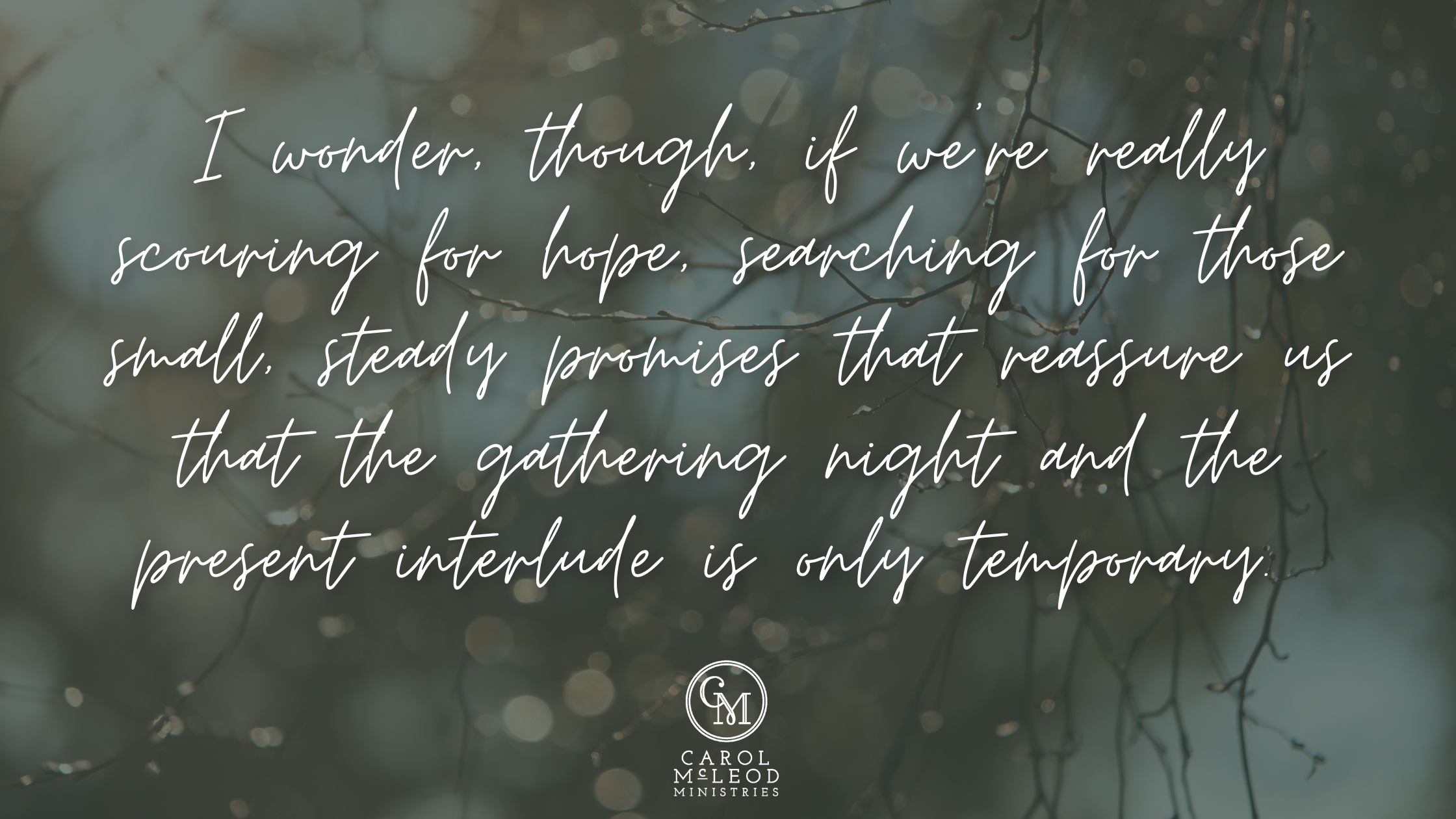Heaven and Nature Sing
A Note from Carol: I love giving some of my friends a voice on my Joy for the Journey blog. Let me introduce you to Hannah Anderson, author of a wonderful new advent devotional called Heaven and Nature Sing. This book invites you into a fresh reading of the Christmas story—one where earthy, overlooked things like snowflakes, trees, serpents, bodies, and swaddling bands reveal the glory of the Promised Son. Journeying from the first pages of Scripture to the last, you’ll experience the goodness of our Creator King and learn how the whole earth sings his praise. Hannah was gracious enough to share one of the chapters with us, and I pray it will be an encouragement to your advent season.
Chapter 1: Wintering
Here, where I live in the mountains of southwest Virginia, December marks the beginning of winter. Night gathers quickly, with a deep darkness settling in by the time we settle around the table. The ground, that only a few months earlier burst with life, lies dormant under a chill that never seems to lift. From the warmth of my kitchen, I look out the window to see my once-lush garden encrusted with ice, full of thick, heavy clods of earth, and littered with the remnants of corn-stalk and pumpkin vine that twist up among the table scraps.
The red raspberry canes stand bare, imitating dead sticks quite believably. The strawberry plot has been rifled for the last bits of fruit, and all that remains are dark, decaying leaves. The herbs have been cut back to their slumbering roots. And on particularly cold mornings, the asparagus I left to bolt is encased in frost, its fern-like leaves crystallized so that each segment is clearly visible.
Closer to the house, ornamental beds of lily, hosta, and peony hide their delicate parts deep within the earth. The grape vine that climbed the arbor in summer and whose clusters hung over us while we ate and drank in the sun is bare, stripped and cut back in expectation of next season. The peach trees raise bony limbs against a perpetual gray sky. And across the way, the fields lay in patchwork browns, punctuated occasionally by tussocks of rusty broom sedge. I can see straight through the thicket of trees now, their naked trunks and leafless branches as thin as wisps of hair on an aging head.
In December, it’s hard to believe that the earth ever brought forth life or that it ever will again.
But winter also brings the holidays, and so we do our best to be merry despite the landscape around us. We wrap bare limbs and sleeping bushes in brightly colored lights, the miracle of electricity compensating for their previous buds and blooms. We stoke fires to make up for the sun’s absence and fuel them with seasoned wood, disproportionately pleased by our ability to salvage light and heat from death. The wintering birds will get an extra helping of seed, and eventually, we’ll cut a tree and drag it into the front room. We’ll scour the woods for bits of green—Virginia pine, holly, eastern hemlock, and if we’re lucky, mistletoe—and drape them along the mantle, windowsills, doorways, and banisters.
I wonder, though, if we’re really scouring for hope, searching for those small, steady promises that reassure us that the gathering night and the present interlude is only temporary. I wonder if, like the earth itself, we’re waiting, holding our breath in anticipation, longing to believe that something more is happening, that something more is coming. I wonder if we’re all just waiting for God to show up.
In Romans 8, the apostle Paul writes that “the sufferings of this present time are not worth comparing with the glory that is going to be revealed to us”—that no matter what we’re currently going through, no matter the heartbreak, no matter the confusion, no matter the grief or loss, God’s goodness and glory await us. That deep, under the surface, out of sight, he is at work. That he always has been, and he always will be. To prove this, Paul turns our attention to the natural world:
For the creation eagerly waits with anticipation for God’s sons to be revealed. For the creation was subjected to futility—not willingly, but because of him who subjected it—in the hope that the creation itself will also be set free from the bondage to decay into the glorious freedom of God’s children.
It’s a strange thing to think of the earth this way—as having a will or having to wait or even having the ability to hope for redemption. Even stranger that the earth would be our partner in hope, longing for freedom and life and glory as much as we do.
But when I look out my window in December, when I see how much the world around me has changed in only a few weeks, when I see its lifeless stillness, I believe it. And when I remember what Genesis tells me—that I was made from that same ice-encrusted earth, that a curse of futility hangs over us both, that “from dust you were taken and to dust you will return”—I know it in my bones.
Yes, the heavens declare the glory of God, and the earth shows forth his handiwork just as Psalm 19 says they do. And yes, when I gaze into the inky blackness of a December night and see a thousand points of light, I can almost hear a chorus of praise. But when I see a mountaintop cut bare for the minerals beneath or I remember the whirlwinds that level neighborhoods or I watch on the news as fires consume home and forest alike, I hear something else. I hear a groaning that mirrors my own. I hear a longing and a pain that cries out for redemption.
And I find in nature an unexpected ally in the work of hope.
So in this season, as we celebrate the Creator who took on flesh and came to his creation, we do so in solidarity with an entire cosmos. Here in these moments of Advent and Nativity, heaven and nature sing, teaching a truth we cannot know without the witness of both. It is a story of bodies and skies and beasts and trees—all waiting for the glory that will be revealed when the Son of God comes to his own. It is a story of longing and incarnation, of the earth receiving a flesh-and-blood Redeemer, first as a Baby and one day forever as its King.
I want to invite you into this story afresh. To consider the Christmas narrative from a slightly different perspective—to think of all the ways Jesus’s coming changed and will change the world. To truly believe that in response to the Savior’s reign, “fields and floods/Rocks, hills and plains/Repeat the sounding joy.”
For as much as we are part of this same creation, made from the very ground that lies beneath our feet, it is our story as well. So that even as our mortal bodies waste away and the ground continues to groan, we take hope. The One who loved the world came to it. And from this love, he will redeem it until both the earth and those made from it slip from the bondage of decay to eternal glory. Until the children of God are revealed.
Because just as Jesus came to this world through birth, the Scripture promises that we enter the heavenly kingdom through rebirth and that one day the earth itself will give birth—not just to another season, but to our resurrected bodies.
And now you know why heaven and nature sing. Now you know why those of us who dwell in the dust must awake and sing along with them, why a chorus of “joy to the world” is on our lips. Here in this season, with its quiet, pervasive witness to both life and death, when we’re most fully aware of the darkness can we become most fully aware of the light. Here our cries for deliverance become songs of praise. And here, between what is and what will be, I am most convinced of the glory that must come.
Because here, where Advent turns to Nativity, creation itself teaches us to hope in our Creator, infant King.

